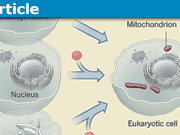What is Evolution: A Beginner’s Guide
Table of Contents
Introduction to Evolution
The study of evolution has dominated the field of biology for over a century. Explaining why the life we see is as it is fascinating scientists and non-scientists alike. Thanks to this fascination there are a number of questions that often come up about evolution; this primer contains some FAQs, key facts, and educational links on evolution.
Key terms
Genome – the entire genetic sequence in an organism
Genotype – the entire complement of genes in an organism
Allele – a version of one gene (genes can have multiple versions)
Gene – sequence of DNA that codes for a protein
Mutation – alteration in the DNA sequence
Phenotype – the entire complement of physical traits shown by an organism (created by the interaction of biology and environment)
What is evolution?
Evolution is the change over time of inheritable traits within a population, the study of evolution looks into the mechanisms that underlie this process. Importantly evolution is not the study of how life first formed, that is the study of Abiogenesis which looks at how the conditions of a primordial Earth could give rise to chemistry that forms very primitive life.
How does evolution work?
At its most basic there are two main phenomena in evolution; Mutation in every nucleated cell in your body. Mutations can cause differences in gene sequence and gene regulation; the former means that the protein coded for by a gene could be different and thus act in a different way (often causing knock-on effects), the latter means that whilst the gene may be fine the process of telling it when to be on (called expressed) and when not to be are different. Both of these can change the phenotype by altering, removing or even adding physical traits to the offspring.
Mutations that occur in germline cells (such as sperm and egg) can be passed down from parent to offspring. These changes in the organism’s genotype compared to its parent mean that the traits observed in the phenotype may also be different. This forms the fundamental basis for evolution.
Once a mutation has occurred selection takes place. Inherited mutations have Mutation types. Biological fitness is a measure of how good an organism is at proliferating its genes and thus is an interplay between the ability to survive and the capacity to reproduce.
Mutations can be classified by their effect on fitness as deleterious (harmful to an organism’s fitness) and advantageous (beneficial to an organism’s fitness). Furthermore, mutations are characterized as “strong” or “weak” depending on the level of effect they have (fatal mutations are strongly deleterious for example). Deleterious mutations are selected against because they decrease the fitness of an organism; the reverse is true for advantageous effects. For example, mutations that cause fatality before puberty strongly reduce fitness (e.g. fatal mitochondrial DNA depletion myopathy caused by mutations in the TK2 gene).
It is very important to remember that whether or not a mutation is deleterious or advantageous strongly depends on the environment. A mutation giving rise to a trait that is advantageous in one environment (e.g. yellow fur in a field of yellow plants) can be deleterious in another environment (e.g. yellow fur in a field of green plants).
It is also vital to note however that advantageous and deleterious mutation of both the strong and weak variety accounts for a very small percentage of all mutations, in actuality the majority of mutations are on the molecular level in the way that they have absolutely no effect on the survival or reproductive fitness of the individual (Kimaru, 1968).
How do organisms know to evolve?
No individual organism actually evolves in nature; rather populations evolve across generations with each generation slightly different from the last. When evolution occurs there is nothing directing it and populations never try to evolve. As Dawkins put it evolution is a blind watchmaker, the processes occur mechanically without any thought. Advantageous mutations are selected simply because they allow the organism to survive and proliferate more than others meaning that a higher proportion of the next generation will possess the beneficial genes.
If you are still confused here’s a simple thought exercise; Imagine you have ten towers made from a random amount of blocks. You measure them all and remove the smallest five. Taking the biggest five you now create two new copies (discarding the old). When building the copies flip a coin for each one and roll a dice; if you roll heads you add on the number of blocks the dice says, if you roll tails you take that amount off. Then repeat the process over and over. You don’t even have to use blocks! simply get a pen and paper and write it out. Over time you will see that because the environment (you) has some selective pressure (tall height) over time mutations (coin and dice) that are beneficial (heads and high numbers) lead to taller and taller towers without any tower actually doing anything. Check out the evolution simulator linked below to see for yourself how this simple process can occur.
Have we ever observed evolution?
Yes, there are many examples of evolution occurring in both the lab and in nature. Some examples include the phenomenon of ring species. Check out some of the links below for more information, examples, and references.
Will humans stop evolving?
There are certain conditions that must be met for evolution to stop, this is described by the Hardy-Weinberg principle;
1) A population must be large
2) No mutations may occur
3) Mating must be random
4) No migration
5) No differential reproductive success
Suffice to say humanity has not met these conditions. There are also good examples of recent human evolution such as selection for CCR5-Δ32 during the Black Death in Europe, these mutations grant some Europeans higher resistance against diseases like smallpox and HIV








Leave a Reply
Want to join the discussion?Feel free to contribute!